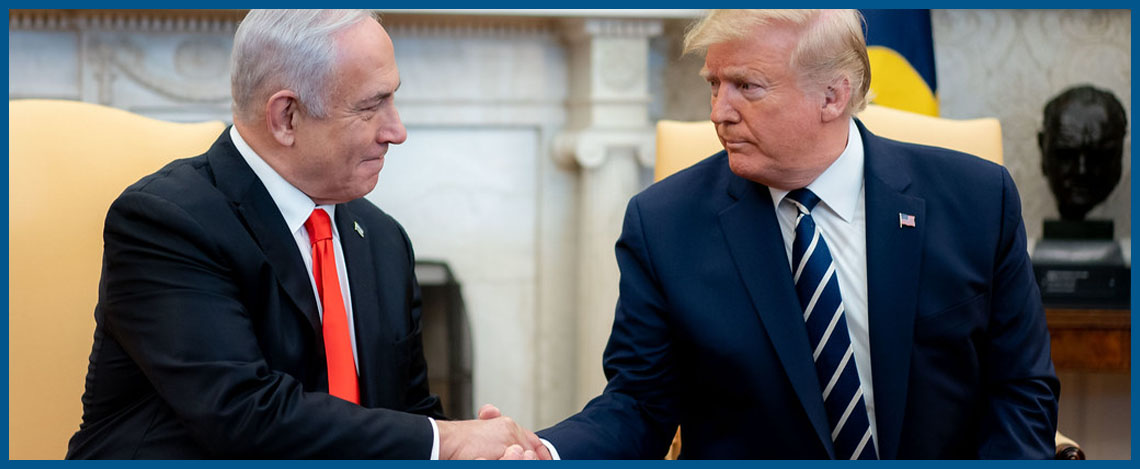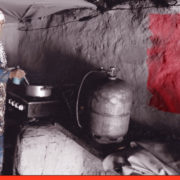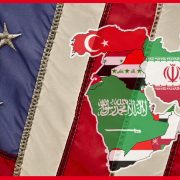On 29 January 2020, President Donald Trump came out revealing his long-awaited deal that he promised is going to be the first of its kind. Undoubtedly it was, but was it for the better? Trump tasked his son-in-law Jared Kushner to do a PR campaign for the deal and convince the Palestinians that this deal is in their favor. Evidently, he failed terribly at this. Palestinians were very assertive in their rejection of the ‘plan’ and called upon everyone to uphold international law and invited Israel to negotiations on the basis of international legitimacy.
Reading the plan, referred to officially as “vision for peace”, one doubts that it had any legal experts in the process of drafting at all. In an interview with an Egyptian TV channel, Kushner proudly mentioned that his background in real estate helped him understand how complex it is to draft such an excellent map for bridges and highways taking into consideration the fast Israeli “growth”. But has his experience in real estate not told him that if a property was not built or traded on sound legal grounds, then it is null and void for violating the rules of law?
The ‘plan’ in the eyes of international law
One can hardly find a conflict that has had this number of resolutions and international legal literature as the Arab-Israeli one. Since 1922, there has been a great deal of resolutions and judicial literature on the legal status of Palestine and its people.
Quite ironically, this very fact was the problem in the eyes of the drafters of Trump’s ‘vision’ for peace. International law was the problem as it offered “unrealistic” and “unachievable” solutions. The text of the vision reads:
“Since 1946, there have been close to 700 United Nations General Assembly resolutions and over 100 United Nations Security Council resolutions in connection with this conflict.”[1]
As bizarre as one can imagine, the vision continues to discredit the UN resolutions calling them “inconsistent”, “time-bound”, and worse -according to the drafters- “have not brought about peace”. It went on to blame the “conflicting interpretations of some of the most significant United Nations resolutions, including United Nations Security Council Resolution 242”. It even went as farther as blaming those resolutions as they have “enabled political leaders to avoid addressing the complexities of this conflict rather than enabling a realistic path to peace”. In fact, these 700 resolutions would have been much more had the US not been using its veto power regularly in favour of Israel.
This vision marks an unprecedented setback in the stance of the United States towards international law and the UN; in founding which, the US had a major role in 1945
The ‘Plan’ never mentioned occupation, apartheid, or even the term ‘two-state solution’; the internationally recognized and legally founded solution.
This vision marks an unprecedented setback in the stance of the United States towards international law and the UN; in founding which, the US had a major role in 1945. It is quite ridiculous that we find ourselves wondering if the drafters were expecting international law and the UN to protect the strong and the occupier instead of the weak victim!?
Indeed, this plan brings the world back in time to World War II era and its preceding events. The tragedy of WWII taught the fighting powers back then a very costly lesson; cooperate or collapse. This has resulted in the establishment of the UN and the concluding of several international conventions that reflected the progress of human civilizations towards a future that would be better than the painful past; a world without a WWIII! Nonetheless, President Trump begs to differ! His ‘Plan’s’ retrogression of the well-established rules of international law, and detraction from international legal regime’s respect, reminds us of a costly past humanity wants so badly to avoid repeating!
The plan went on to handle a number of issues thinking ‘out of the box’; the box stands for international legal regime in this case:
- A non-sovereign Palestinian archipelago of Bantustans:
Palestinian President Mahmoud Abbas called the state he has been offered a “Swiss Cheese”, and it seems quite hard to prove him wrong. An archipelago of isolated Bantustans (the term used in the vision was “enclaves”) that are connected by narrow highways supervised by Israel, is the foundation of the Palestinian state that President Trump is suggesting. According to UNSC resolution 242, that was the basis of the two-state solution, Palestinian state would exist on the territories occupied in 1967, which is around 20-22% of the total size of Mandate-Palestine. However, the new “opportunity” Trump is offering means that the potential sovereign state of Palestine would exist on around 15% of the total land.
Michael Lynk, the UN Special Rapporteur, described the state Trump is offering as a “Potemkin state” that lacks most attributes of a state and “would become an entirely new entity in the annals of modern political science.”
- Borders and Settlements
According to the plan [p. 8-9], “forced population transfers of either Arab or Jews” would be avoided and hence settlements would remain. The illegal settlements would be annexed to Israel and settlers would be governed by Israeli civil law. Jordan Valley is attributed to Israel on the grounds that it is “essential for Israel’s national security”. The “opportunity” would eat up further 30-40% of the West Bank and give it to Israel.
None of the numerous UNSC and UNGA or even the ICJ advisory opinions, that decisively label settlements as illegal, was even referred to or mentioned anywhere in the ‘Plan’.
In international law, acquiring territory through the use of force is illegitimate, and the non-recognition of all states to this annexation is considered as ‘erga omnes’ (obligatory on all states). This is a settled issue and there is no other legal opinion on forceful annexation whatsoever!
- Refugees
Contrary to common belief, Palestinian Right of Return for the refugees was not ‘established’ by UNGA resolution 194, but rather asserted by it. According to the ‘Plan’ [p.9] “Proposals that demand that the State of Israel agree to take in Palestinian refugees, or that promise tens of billions of dollars in compensation for the refugees, have never been realistic and a credible funding source has never been identified”.
Hence, it explicitly concludes that “there shall be no right of return by, or absorption of, any Palestinian refugee into the State of Israel.” The ‘realistic’ solution according to the vision is that “[t]heir Arab brothers have the moral responsibility to integrate them into their countries as the Jews were integrated into the State of Israel.”
The ‘Plan’ never states that Palestinian refugees would be compensated by Israel, that forced them out in the first place, but rather emphasizes the right of “Jewish refugees” from Arab countries for full compensation for their lost assets.
Palestinian right of return and compensation has been asserted repeatedly in tens of UNGA resolutions and is considered as customary international law.[2] This seems to have skipped the attention of the drafters of this ‘Plan’.
- Jerusalem annexed in entirety
As per the US recognition of Jerusalem as the capital of Israel back in 2017, the ‘Plan’ confirms that Jerusalem is the indivisible capital of Israel. The ‘Plan’ generously offers that Palestinians may establish their own capital and name it “Al-Quds” (Arabic term for Jerusalem) anywhere behind the security barrier; out of the City basically. [p.17]
Again, no mention was made for any of the resolutions that explicitly condemned Israeli annexation, nor the 2017 UNGA resolution condemning US recognition of Jerusalem as the capital of Israel calling it to withdraw the declaration.
A declaration of Apartheid?
Apartheid, a south African term that means ‘apart-hood’, has been defined by the 1973 Apartheid Convention as the “inhuman acts committed for the purpose of establishing and maintaining domination by one racial group of persons over any other racial group of persons and systematically oppressing them”. Several high-level reports have asserted that Israel has established a full-fledged apartheid regime over the Palestinians; similar or even worse than that of South Africa. Some have even argued that Israel has been an Apartheid State all along (Folk, 2017).
What is new about this ‘Plan’ is that it officiates the status of Israel as an apartheid state with the blessing of the world’s superpower; the United States. Palestinians would now have to live under a hybrid regime of Apartheid. Palestinians of West Bank and Gaza live under a non-sovereign entity under the supervision of Israel. Those in Jerusalem live as ‘permanent residents’ and deprived of political and civil rights. Palestinian citizens of Israel (around 20%) live as second class citizens after the Nation State Law of 2018 (Beaumont, 2018), which stipulates that only Jews have the right of self-determination. Finally, Palestinian refugees are deprived of return.
Considerably, the map of the archipelago the ‘Plan’ is offering looks quite similar to the South African Bantustans made by the White ruling elite for the black South Africans. Interestingly, both systems of apartheid cited the same reasons: security purposes.

Where is the conflict heading?
Regrettably, the ‘Plan’s extensive use of terms of the like of “realistic”, “achievable” and “new facts on the ground” makes it clear that the US and Israel are viewing the conflict from power-based lenses instead of rights-based one. It is the “new facts” created by several war crimes and crimes against humanity that decide what shape the solution should take. This certainly would lead to prolonging the conflict and give rise to the use of force.
Neither the world has a stomach for an apartheid regime nor Palestinians would accept to be enslaved by “the only democracy in the Middle East”.
If Palestinians are left alone in this fight, everybody would lose; something all reactionary forces that believe in jungle law would love to see happening.
Everyone’s fight: the way forward
Trump’s vision for peace has made it clearer than ever before; Palestinian fight for freedom and their basic rights is not Palestinian, and should never be so. Palestinian struggle is an international struggle against racism, subjugation and reactionarism. It is a fight for the concept of freedom, equality, human rights and international law itself. If Palestinians are left alone in this fight, everybody would lose; something all reactionary forces that believe in jungle law would love to see happening.
In light of this, Palestinians and all those who want to save human progress in human rights and international law, should seek all the possible means to stop murdering international law. Some of the possible options would be:
- Resorting to the UN General Assembly for a resolution condemning the ‘Plan’ and reemphasizing what international law clearly states. Israel should also be officially named an apartheid state through a resolution.
- Referring to the International Court of Justice through the UNGA, or directly as Palestine already did when it sued the US for relocating its embassy to Jerusalem, utilizing its membership in UNSCO to accede to Vienna Convention for Law of Treaties allowing it to sue the US.[3]
- Continue with the International Criminal Court path to reinforce the fact that Israel is an apartheid state, considering that the crime of Apartheid falls under the jurisdiction of the ICC.
- Activating all legal principles in local laws worldwide to sue Israeli war criminals and perpetrators of crimes against humanity wherever possible.
- Joining hands with campaigns of the like of BDS and protest Israeli crimes and violations on the ground, such as the Great Return March.
It is necessary to repeat: if Palestinians lose this fight, everybody loses, including Israel and the US themselves!
[1] For the full text on this regard, check Part A: Political Framework, page 5 of the ‘Plan’ – (Peace to Prosperity).
[2] Quigley, J. (1998). Displaced Palestinians and a Right of Return. Harv. Int’l. LJ, 39, 171
[13] See Palestine’s submission to ICJ; SUBMISSION, (2018). “APLICATION INSTITUTING PROCEEDINGS: PALESTINE VS UNITED STATES OF AMERICA”. Page 10, footnote 10. Retrieved on March 25, 2020 from: https://www.icj-cij.org/files/case-related/176/176-20180928-APP-01-00-EN.pdf
Visto International bears no responsibility for the content of the articles published on its website. The views and opinions expressed in these articles are those of the authors and do not necessarily reflect the official policy or position of the Organisation. All writers are encouraged to freely and openly exchange their views and enrich existing debates based on mutual respect.










